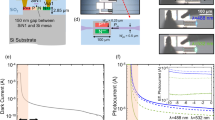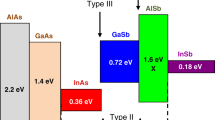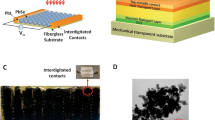Abstract
The ability to detect single photons has led to the advancement of numerous research fields1,2,3,4,5,6,7,8,9,10,11. Although various types of single-photon detector have been developed12, because of two main factors—that is, (1) the need for operating at cryogenic temperature13,14 and (2) the incompatibility with complementary metal–oxide–semiconductor (CMOS) fabrication processes15,16—so far, to our knowledge, only Si-based single-photon avalanche diode (SPAD)17,18 has gained mainstream success and has been used in consumer electronics. With the growing demand to shift the operation wavelength from near-infrared to short-wavelength infrared (SWIR) for better safety and performance19,20,21, an alternative solution is required because Si has negligible optical absorption for wavelengths beyond 1 µm. Here we report a CMOS-compatible, high-performing germanium–silicon SPAD operated at room temperature, featuring a noise-equivalent power improvement over the previous Ge-based SPADs22,23,24,25,26,27,28 by 2–3.5 orders of magnitude. Key parameters such as dark count rate, single-photon detection probability at 1,310 nm, timing jitter, after-pulsing characteristic time and after-pulsing probability are, respectively, measured as 19 kHz µm−2, 12%, 188 ps, ~90 ns and <1%, with a low breakdown voltage of 10.26 V and a small excess bias of 0.75 V. Three-dimensional point-cloud images are captured with direct time-of-flight technique as proof of concept. This work paves the way towards using single-photon-sensitive SWIR sensors, imagers and photonic integrated circuits in everyday life.
This is a preview of subscription content, access via your institution
Access options
Access Nature and 54 other Nature Portfolio journals
Get Nature+, our best-value online-access subscription
$29.99 / 30 days
cancel any time
Subscribe to this journal
Receive 51 print issues and online access
$199.00 per year
only $3.90 per issue
Buy this article
- Purchase on Springer Link
- Instant access to full article PDF
Prices may be subject to local taxes which are calculated during checkout




Similar content being viewed by others
Data availability
The data supporting this work are available in the main text, figures and Methods. Further information is available from the corresponding author.
Code availability
The codes supporting this work are for extracting the data from the equipment and plotting the data in figures. Further information is available from the corresponding author.
References
Politi, A., Matthews, J. C. F. & O’Brien, J. L. Shor’s quantum factoring algorithm on a photonic chip. Science 325, 1221 (2009).
Zhong, H.-S. et al. Quantum computational advantage using photons. Science 370, 1460–1463 (2020).
Waks, E. et al. Quantum cryptography with a photon turnstile. Nature 420, 762 (2002).
Lai, S.-K. et al. Satellite-relayed intercontinental quantum network. Phys. Rev. Lett. 120, 030501 (2018).
Brida, G., Genovese, M. & Ruo Berchera, I. Experimental realization of sub-shot-noise quantum imaging. Nat. Photon. 4, 227–230 (2010).
Zarghami, M. et al. A 32 × 32-pixel CMOS imager for quantum optics with per-SPAD TDC, 19.48% fill-factor in a 44.64-μm pitch reaching 1-MHz observation rate. IEEE J. Solid-State Circuits 55, 2819–2830 (2020).
Bruschini, C., Homulle, H., Antolovic, I. M., Burri, S. & Charbon, E. Single-photon avalanche diode imagers in biophotonics: review and outlook. Light Sci. Appl. 8, 87 (2019).
Pawlikowska, A. M., Halimi, A., Lamb, R. A. & Buller, G. S. Single-photon three-dimensional imaging at up to 10 kilometers range. Opt. Express 25, 11919–11931 (2017).
Kuzmenko, K. et al. 3D LIDAR imaging using Ge-on-Si single-photon avalanche diode detectors. Opt. Express 28, 1330–1344 (2020).
Entwistle, M. et al. Geiger-mode APD camera system for single-photon 3D LADAR imaging. In Proc. SPIE Vol. 8375, Advanced Photon Counting Techniques VI, 83750D (SPIE, 2012).
Morimoto, K. et al. Megapixel time-gated SPAD image sensor for 2D and 3D imaging applications. Optica 7, 346–354 (2020).
Hadfield, R. H. Single-photon detectors for optical quantum information applications. Nat. Photon. 3, 696–705 (2009).
Marsili, F. et al. Detecting single infrared photons with 93% system efficiency. Nat. Photon. 7, 210–214 (2013).
Najafi, F. et al. On-chip detection of non-classical light by scalable integration of single-photon detectors. Nat. Commun. 6, 5873 (2015).
Campbell, J. C., Sun, W., Lu, Z., Itzler, M. A. & Jiang, X. Common-mode cancellation in sinusoidal gating with balanced InGaAs/InP single photon avalanche diodes. IEEE J. Quantum Electron. 47, 1505–1511 (2012).
Signorelli, F. et al. Low-noise InGaAs/InP single-photon avalanche diodes for fiber-based and free-space applications. IEEE J. Sel. Top. Quantum Electron. 28, 3801310 (2022).
Xu, H., Pancheri, L., Dalla Betta, G.-F. & Stoppa, D. Design and characterization of a p+/n-well SPAD array in 150nm CMOS process. Opt. Express 25, 12765–12778 (2017).
Lee, M.-J. et al. High-performance back-illuminated three-dimensional stacked single-photon avalanche diode implemented in 45-nm CMOS technology. IEEE J. Sel. Top. Quant. Electron. 24, 3801809 (2018).
Sliney, D. H. & Freasier, B. C. Evaluation of optical radiation hazards. Appl. Opt. 12, 1–24 (1973).
Bird, R. E., Hulstrom, R. L. & Lewis, L. J. Terrestrial solar spectral data sets. Sol. Energy 30, 563–574 (1983).
Arnulf, A., Bricardi, J., Cura, E. & Varet, C. Transmission by haze and fog in the spectral region 0.35 to 10 microns. J. Opt. Soc. Am. 47, 491–498 (1957).
Loudon, A. Y. et al. Enhancement of the infrared detection efficiency of silicon photon-counting avalanche photodiodes by use of silicon germanium absorbing layers. Opt. Lett. 27, 219–221 (2002).
Tosi, A., Dalla Mora, A., Zappa, F. & Cova, S. Germanium and InGaAs/InP SPADs for single-Photon detection in the near-infrared. In Proc. SPIE Vol. 6771, Advanced Photon Counting Techniques II, 67710P (SPIE, 2007).
Lu, Z. et al. Geiger-mode operation of Ge-on-Si avalanche photodiodes. IEEE J. Quantum Electron. 47, 731–735 (2011).
Warburton, R. E. et al. Ge-on-Si single-photon avalanche diode detectors: design, modeling, fabrication, and characterization at wavelengths 1310 and 1550 nm. IEEE Trans. Electron Devices 60, 3807–3813 (2013).
Martinez, N. J. D. et al. Single photon detection in a waveguide-coupled Ge-on-Si lateral avalanche photodiode. Opt. Express 25, 161310–16139 (2017).
Vines, P. et al. High performance planar germanium-on-silicon single-photon avalanche diode detectors. Nat. Commun. 10, 1086 (2019).
Ferre Llin, L. et al. High sensitivity Ge-on-Si single-photon avalanche diode detectors. Opt. Lett. 45, 6406–6409 (2020).
Ke, S. et al. Design of wafer-bonded structures for near room temperature Geiger-mode operation of germanium on silicon single-photon avalanche photodiode. Appl. Opt. 56, 4646–4653 (2017).
Soref, R. A., De Leonardis, F. & Passaro, V. M. N. Simulations of nanoscale room temperature waveguide-coupled single-photon avalanche detectors for silicon photonic sensing and quantum applications. ACS Appl. Nano Mater. 2, 7503–7512 (2019).
Thorburn, F. et al. Ge-on-Si single-photon avalanche diode detectors for short-wave infrared wavelengths. J. Phys. Photonics 4, 012001 (2022).
Samavedam, S. B., Currie, M. T., Langdo, T. A. & Fitzgerald, E. A. High-quality germanium photodiodes integrated on silicon substrates using optimized relaxed graded buffers. Appl. Phys. Lett. 73, 2125–2127 (1998).
Luan, H.-C. et al. High-quality Ge epilayers on Si with low threading-dislocation densities. Appl. Phys. Lett. 75, 2909–2911 (1999).
Osmond, J. et al. Ultralow dark current Ge/Si(100) photodiodes with low thermal budget. Appl. Phys. Lett. 94, 201106 (2009).
Åberg, I. et al. A low dark current and high quantum efficiency monolithic germanium-on-silicon CMOS imager technology for day and night imaging applications. In Proc. 2010 International Electron Devices Meeting (IEDM) 14.4.1–14.4.4 (IEEE, 2010).
Lee, K.-H. et al. Defects reduction of Ge epitaxial film in a germanium-on-insulator wafer by annealing in oxygen ambient. APL Mater. 3, 016102 (2015).
Morse, M., Dosunmu, O., Sarid, G. & Chetrit, Y. Performance of Ge-on-Si p-i-n photodetectors for standard receiver modules. IEEE Photon. Technol. Lett. 18, 2442–2444 (2006).
Takenaka, M., Morii, K., Sugiyama, M., Nakano, Y. & Takagi, S. Dark current reduction of Ge photodetector by GeO2 surface passivation and gas-phase doping. Opt. Express 20, 8718–8725 (2012).
Sammak, A., Aminian, M., Nanver, L. K. & Charbon, E. CMOS-compatible PureGaB Ge-on-Si APD pixel arrays. IEEE Trans. Electron Devices 63, 92–99 (2016).
Kang, Y. et al. Monolithic germanium/silicon avalanche photodiodes with 340 GHz gain–bandwidth product. Nat. Photon. 3, 59–63 (2008).
Duan, N., Liow, T.-Y., Lim, A. E.-J., Ding, L. & Lo, G. Q. 310 GHz gain-bandwidth product Ge/Si avalanche photodetector for 1550 nm light detection. Opt. Express 20, 11031–11036 (2012).
Huang, M. et al. Germanium on silicon avalanche photodiode. IEEE J. Sel. Top. Quantum Electron. 24, 3800911 (2018).
Assefa, S., Xia, F. & Vlasov, Y. A. Reinventing germanium avalanche photodetector for nanophotonic on-chip optical interconnects. Nature 464, 80–84 (2010).
Virot, L. et al. Germanium avalanche receiver for low power interconnects. Nat. Commun. 5, 4957 (2014).
Chen, H. T. et al. High sensitivity 10Gb/s Si photonic receiver based on a low-voltage waveguide-coupled Ge avalanche photodetector. Opt. Express 23, 815–822 (2015).
Su, Y. K., Chang, C. Y. & Wu, T. S. Temperature dependent characteristics of a PIN avalanche photodiode (APD) in Ge, Si and GaAs. Opt. Quantum Electron. 11, 109–117 (1979).
Hofbauer, M., Steind, B. & Zimmermann, H. Temperature dependence of dark count rate and after pulsing of a single-photon avalanche diode with an integrated active quenching circuit in 0.35 μm CMOS. J. Sens. 2018, 9585931 (2018).
Mahmoudi, H., Hofbauer, M., Goll, B. & Zimmermann, H. Noise and breakdown characterization of SPAD detectors with time-gated photon-counting operation. Sensors 21, 5287 (2021).
Ziarkash, A. W., Joshi, S. K., Stipčević, M. & Ursin, R. Comparative study of afterpulsing behavior and models in single photon counting avalanche photo diode detectors. Sci. Rep. 8, 5076 (2018).
Na, N. et al. High-performance germanium-on-silicon lock-in pixels for indirect time-of-flight applications. In Proc. 2018 International Electron Devices Meeting (IEDM) 32.4.1–32.4.4 (2018).
Acknowledgements
We thank C. H. Shen and D. Y. Lai for the discussion on the fabrication equipment, process and metrology.
Author information
Authors and Affiliations
Contributions
N.N. conceived the design, supervised the project, and wrote the paper. Y.-C. Lu contributed to device simulation, layout synthesis and wafer-level data analysis. Y.-H.L. contributed to layout synthesis, process integration and wafer-level data analysis. P.-W.C. and Y.-C. Lai contributed to process integration and device fabrication. Y.-R.L. contributed to process integration and wafer-level data analysis. C.-C.L. contributed to wafer-level data collection and analysis. T.S. contributed to die-level data collection and analysis and 3D PCL image capture. C.-H.C. contributed to die-level data collection and analysis. S.-L.C. oversaw the project.
Corresponding author
Ethics declarations
Competing interests
All authors are shareholders of Artilux Inc., a start-up company that makes SWIR 2D/3D sensors, imagers and photonic integrated circuits.
Peer review
Peer review information
Nature thanks the anonymous reviewers for their contribution to the peer review of this work. Peer reviewer reports are available.
Additional information
Publisher’s note Springer Nature remains neutral with regard to jurisdictional claims in published maps and institutional affiliations.
Extended data figures and tables
Supplementary information
Rights and permissions
Springer Nature or its licensor (e.g. a society or other partner) holds exclusive rights to this article under a publishing agreement with the author(s) or other rightsholder(s); author self-archiving of the accepted manuscript version of this article is solely governed by the terms of such publishing agreement and applicable law.
About this article
Cite this article
Na, N., Lu, YC., Liu, YH. et al. Room temperature operation of germanium–silicon single-photon avalanche diode. Nature 627, 295–300 (2024). https://doi.org/10.1038/s41586-024-07076-x
Received:
Accepted:
Published:
Issue Date:
DOI: https://doi.org/10.1038/s41586-024-07076-x
Comments
By submitting a comment you agree to abide by our Terms and Community Guidelines. If you find something abusive or that does not comply with our terms or guidelines please flag it as inappropriate.



